June has arrived, bringing with it our highly anticipated Online Live Auction! Global Auction is thrilled to present an extraordinary selection of over 147 curated Modern and Contemporary Artworks from Southeast Asian Maestros and esteemed artists. This month's highlights feature exceptional works that are not only visually stunning but also highly collectible. In this article, we delve into the standout pieces of June's collection, exploring why these highlights and other remarkable works are must-haves for art enthusiasts and new collectors.
Affandi
Considered one of Southeast Asia’s most accomplished master artist, Affandi has held solo exhibitions in Indonesia and toured Europe, represented Indonesia in international exhibitions in Brazil and Venice, won first prize at San Paolo, and held a solo exhibition at World House Gallery New York. In addition to his domestic and international exhibitions, Affandi also has received the title of Doctor Honoris Causa from the University of Singapore, was honored with the title of Grand Maestro from San Marzano, Florence, Italy, and received many more prestigious awards.
Starting from the Indonesian Maestro: Affandi. In this June’s collection, we have three of his curated works with different themes. Each of them holds a special characteristic that vividly showcases Affandi's unique style and emotional depth.
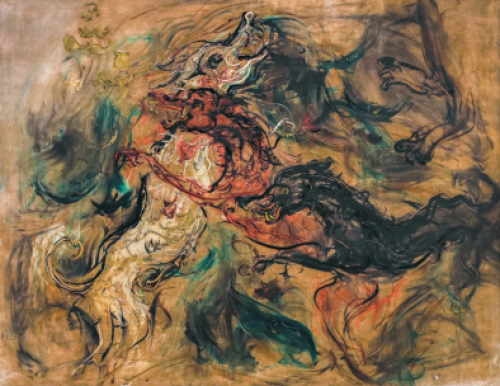
Affandi
Three Stray Dogs, 1965
111 x 139cm; oil on canvas
Est. SGD 102,000 – 127,000
The present lot, titled "Three Stray Dogs," is one of Affandi's exceptional pieces. The inspiration of this work came from his observation of Mr. Jimin, his driver, feeding a pack of stray dogs under a sandalwood tree in Bali. The maestro often sought inspiration for his paintings during his frequent visits to Bali.
The dogs, ravenously devouring the food and fighting each other, intrigued Affandi. He was moved by this scene which reflects how people often act similarly like these dogs, fighting and competing against each other to their own detriment. This natural phenomena of Stray dogs has been a recurring theme in Affandi’s works.
Executed in 1965, this work is from the private collection of Alex Papadimitriou. Affandi depicts three dogs, one in shades of black, another in red, and the third in white. The dramatic contrast across the entire canvas intensifies the portrayal of the fighting dogs. The spontaneous and varying intensity of painting using his hand and fingers captures the movement, emotions and intensity of the scene. Affandi’s signature symbol of “Sun, Feet and Hands” is drawn at the top left of the work, indicating the Maestro’s personal satisfaction toward this particular masterpiece.
Affandi's artworks deliver a window into his interests, spanning from landscapes, figures, and fauna to coastal life, all of which are his favorite subjects. Growing up in coastal areas, Affandi has a deep connection with the coast and the livelihoods of fishermen.
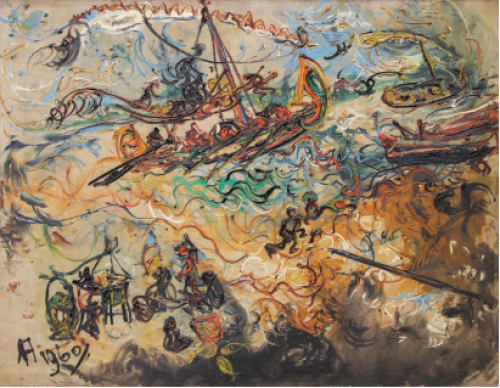
Affandi
Seascape of the Java Sea, 1960
104 x 124 cm; oil on canvas
Est. SGD 95,000 – 153,000
In the work titled "Fishing Boats," the beauty of a lively fisherman village is depicted, with traditional fishing boats of distinctive shapes and colors filling the coast from left to right in red, green, orange, black, and blue. Looking at the beach, you can see people engaged in various activities. On the left, several people can be seen selling fish, a common scene in fisherman villages.
S. Sudjojono
Maestro S. Sudjojono is a well-known painter for his honesty and sincerity, reflecting colors, shapes, and proportions as he observes them. To truly value his art, we need to grasp his dedication. Since the times of struggle, he boldly portrayed realistic situations or actual conditions in Indonesia using his distinctive impressionist style. When painting an object, Sudjojono always understands the character and momentary characteristics of the object being painted.
Born in 1913 in Kisaran, Sudjojono is widely considered the "Father of Modern Indonesian Painting". His influence went far beyond the canvas. Sudjojono's artistic achievements were many. He wasn't just a gifted painter but a sculptor, ceramicist, and furniture maker too.
But Sudjojono wasn't just an artist; he was a leader. He co-founded PERSAGI, the Association of Indonesia's Drawing Experts, a key organization that helped shape the course of modern Indonesian art. His dedication to nurturing artistic talent extended to his role as a mentor at POETERA, the Department of Cultural Affairs.
Sudjojono's legacy extends beyond Indonesia. His works have been exhibited internationally, including at the prestigious Rijksmuseum Amsterdam. The recognition and appreciation for his work speaks volumes. Some of his paintings have even fetched over a million dollars at various auction houses, a proof to his enduring influence on the art world.
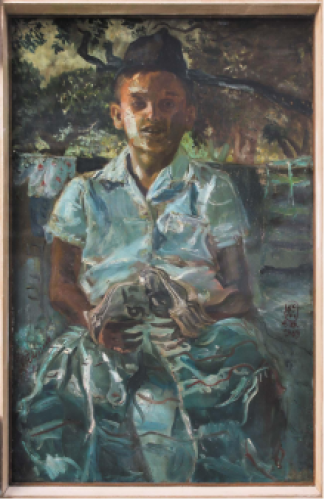
S. Sudjojono
Abang Rahino, 1969
95 x 60 cm; oil on canvas
Est. SGD 85,000 – 127,000
In this present lot, S. Sudjojono painted his son, Abang Rahino. Prior to the final exam at grade six elementary school in 1969, Abang Rahino-whose nickname is Rino-studied religion subject. As his father S.Sudjojono saw him, he invited Rino to his studio and painted the present lot within ninety minutes. S.Sudjojono asked Rino to wear his sarong, while the black cap was borrowed from Thamrin Dilapanga, one of their relatives from Manado. S.Sudjojono took the "ngaji" terminology as he thinks it is more precise than the common term "belajar" in Bahasa Indonesia for learning or studying.
This painting shows Rino in a white shirt with a hint of white, grey and blue hue, and black peci (cap), smiling widely while holding a book with both hands. In the background, Sudjojono added trees and plants in dark green and brown shades. Throughout this painting, Sudjojono shows his mastery in his distinctive impressionistic style using spontaneous and bold strokes of paint that form a detailed picture to the eye. Sudjojono also shows his mastery in realistic perception, creating a sense of depth between his subject and its background.
Srihadi Soedarsono
With over five decades of experience in the art world, Srihadi Soedarsono is considered one of the greatest Indonesian painters. Born in Solo on December 4, 1931, Srihadi Soedarsono's passion for arts led him to pursue studies at the prestigious Institute of Technology Bandung in 1958. Driven by a desire to broaden his skills, Srihadi studied fine arts of the United States at Ohio State University from 1960 to 1962. His works graced exhibitions in Indonesia, the United States, Australia, and even Brazil. This international recognition was further amplified by prestigious cultural awards. In 1971, he received the honor of a cultural award from his home country, Indonesia, followed by another in 1973 from Australia.
He achieved a remarkable feat in 1978 and again in 1987, securing the highest award at the Biennial Exhibition in Jakarta. This prestigious recognition strengthened his position as a leading figure in Indonesian art. He shared his knowledge and passion with the next generation, serving as a senior lecturer in painting and drawing at two esteemed institutions: the Jakarta Institute of Arts and the Bandung Institute of Technology.
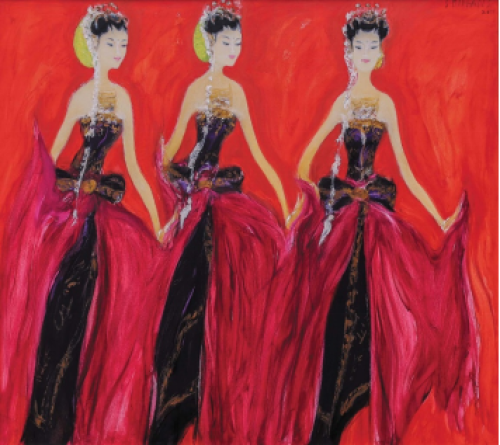
Srihadi Soedarsono
Bedoyo Ketawang-Energy of Inner Beauty; 2010
95 x 60 cm; oil on canvas
Est. SGD 85,000 – 127,000
One of his precious works is titled "Bedoyo Ketawang-Energy of Inner Beauty" that portrays the unique beauty of the dance from the Surakarta Palace, which is exclusively performed during special occasions within the palace premises. The three dancers are adorned from head to toe, resembling a princess bride from the palace. They wear a golden bun adorned with white jasmine flowers cascading down to the waist, accompanied by an exquisite copper-colored necklace.
This dance exudes energy, elegance, and authority, skillfully captured and depicted by Srihadi through his brushstrokes and color transitions. The dancers wear black attire with subtle hints of purple and brown. The red shawl that is tied with a golden belt enhances the sense of movement by incorporating strokes that direct our gaze to the dancers' hand.
Lee Man Fong
Lee Man Fong has successfully combined the Chinese and Western styles in his art. The majority of his life was spent in Indonesia, where he crafted a distinct artistic style that harmoniously combined diverse influences to form his serene yet fervent artistic perspective. He was granted a Malino scholarship endorsed by Dutch Viceroy Hubertus van Mook while his artistic reputation continued to rise. He frequently used Chinese brushwork techniques while applying Western visual conventions to his composition. A prominent painter and curator, his innovative approach introduced the Nanyang style to 20th-century Indonesia. Lee Man Fong's body of work reflects his deep connection to the natural environment, celebrating the wildlife and countryside of Southeast Asia.
As a renowned artist, he gained widespread recognition and went on to showcase his work in prominent cities such as Paris, Amsterdam, and The Hague. His remarkable talent and dedication to his work earned him a significant role in the Yinhua Meishu Xiehui (Society of Chinese Artists in Indonesia), which he led from 1955 to 1961. His reputation and skill led to an esteemed position as a palace artist for President Sukarno. For five years, he created art that adorned the halls of the presidential palace, further cementing his status as a key figure in Indonesian art. Today, his works are preserved in major public collections. His works are held at the Oei Hong Djien (OHD) Museum in Indonesia and his art is part of the prestigious collection at the National Gallery Singapore, ensuring that his contributions to the art world are recognized and appreciated across the region.
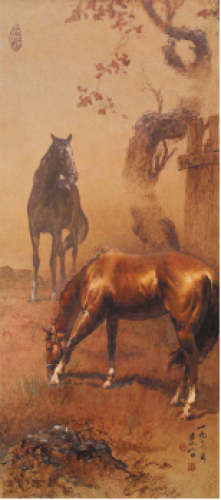
Lee Man Fong
Horses
95 x 60 cm; oil on board
Est. SGD 55,000 – 72,000
In this painting, Lee Man Fong portrays two horses in varying shades of brown. The horse at the forefront is eating the grass while the one behind stands majestically. Additionally, he included a tree with a twisted trunk on the right. Horses have been admired for their strength, beauty, and grace. Moreover in Chinese traditions Horses hold historical importance as they were used in wars, which now translate as a symbol of power and bravery. In Lee Man Fong oeuvre the 12 Chinese zodiacs are often depicted and among the 12, Horses are one of the rarest to be painted.

Lee Man Fong;
Twelve Goldfish
95 x 60 cm; oil on board
Est. SGD 55,000 – 72,000
In this painting, these goldfish aren't just decorative; in Chinese culture, they hold a special symbolism, and a set with twelve of them carries a particularly promising meaning. The number twelve resonates deeply in Chinese beliefs. It represents the twelve cyclical animals of the zodiac, each influencing a year in the grand cycle of time. Twelve months make a year, and twelve hours mark the day and night. Goldfish themselves are seen as lucky creatures, representing wealth and prosperity. The fish, with its graceful movements and flowing fins, embodies abundance and vitality.
Having twelve goldfish, then, signifies a wish for overflowing wealth and success throughout the entire year, for each fish to bring its own portion of prosperity. It's a visual reminder to strive for abundance but also to find harmony within that abundance, just as the goldfish gracefully swim in their shared space.
I Gusti Ayu Kadek Murniasih
Better known as I GAK Murniarsih, she was the first Balinese painter whose work was collected by the Tate Modern Gallery, London, National Gallery Singapore and Australia, National Museum of World Cultures, Leiden, the Netherlands, and many more. Born in Tabanan, Bali in 1966, Murni uses art as a form of therapy, as a personal historical record, and as a daily practice. Self-taught to develop her artistic talents, Murni explores the themes of her work in both two and three dimensions. During her learning process, Murni studied with traditional painter Dewa Putu Mokoh, which allowed her to refine her skills on canvas.
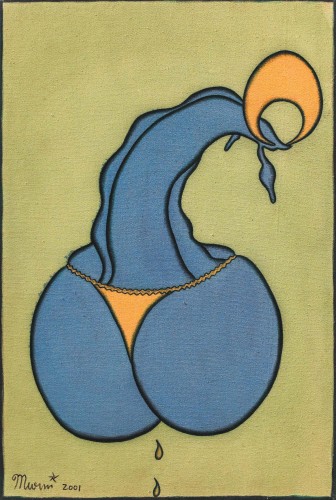
I Gusti Ayu Kadek Murniasih
I am in a Hot Mood; 2001
60 x 40 cm; Acrylic on canvas
Est. SGD 5,000 – 7,000
Themes of sexuality and the struggles of women are prominent in Murni's art, influenced by her personal experiences. The trauma she endured as a victim of sexual violence compelled her to express her emotions on canvas. While not everyone may push the boundaries of what is considered taboo and talk about such themes in public, Murni's main themes in her works revolve around them, very distinct from the Balinese style or art genre prevalent during her productive years. However, over time, experts have come to appreciate her work. Murni's popularity has led to group and solo exhibitions, and her work has been featured in international art exhibitions and museum collections.
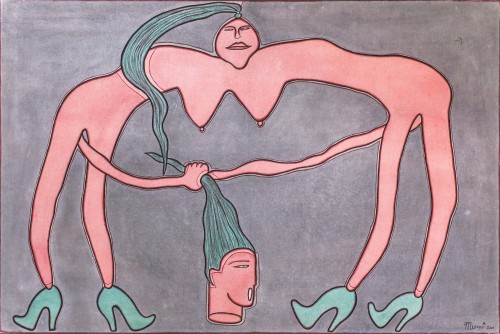
I Gusti Ayu Kadek Murniasih
Between the Shoulders; 2001
100 x 150 cm; Acrylic on canvas
Est. SGD 15,000 – 20,000
Since 2019, her art has been exhibited in numerous art fairs across Indonesia, Singapore, Japan, the Philippines, and Hong Kong, including prestigious events like Art Basel Hong Kong and Basel. From October 11-15, 2023, Murni was presented at the Frieze Masters, and she exhibited in the Biennale of Sydney in 2024. These exhibitions have significantly increased her recognition among art enthusiasts in Hong Kong, Japan, and the Philippines
Ahmad Sadali
Ahmad Sadali is a pioneer in the development of Indonesian abstract art. His paintings are not mere artworks, but rather the result of a profound life journey. This journey involves his hardships, as well as rituals such as prayer and fasting, which imbue Sadali's work with a spiritual essence. While not everyone may comprehend every message conveyed by an abstract painting, these works are not meant to be universally interpreted or understood. Instead, they are intended to be appreciated with the diverse interpretations of each art enthusiast.
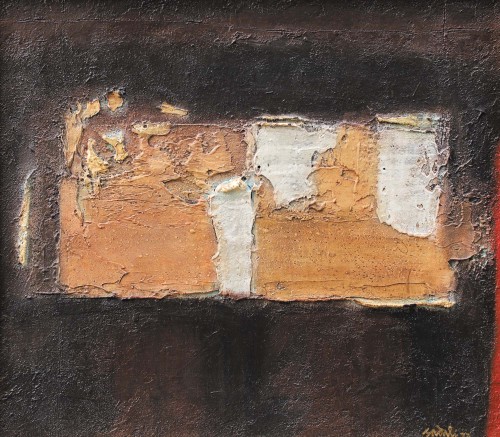
Ahmad Sadali
Gold Bar on Black Field, 1972
40 x 45 cm; Mixed Media on Canvas
Est. SGD 13,000 – 17,000
Also known as the father of Indonesian abstract art, Sadali graduated from the Department of Art at the Bandung Institute of Technology (ITB) in 1953, where he later became a professor in the Art Department in 1972. He received a grant from the Rockefeller Foundation to study at Iowa State University and the New York Art Students League in the USA from 1956 to 1957. In addition, he pursued further studies in the Netherlands and Australia in 1977, and in Pakistan in 1980.
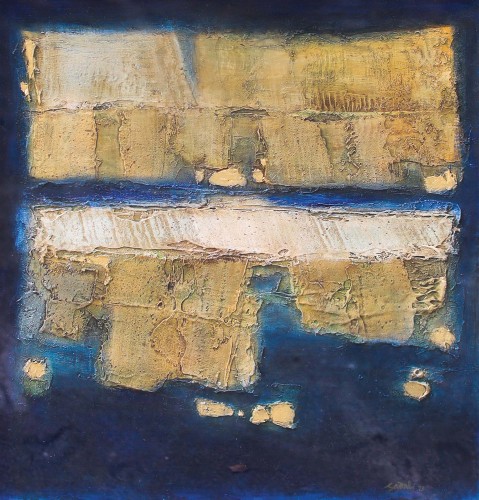
Ahmad Sadali
Gold Bar on Black Field, 1972
40 x 45 cm; Mixed Media on Canvas
Est. SGD 13,000 – 17,000
He held solo exhibitions in Jakarta, Surabaya, Bandung, and Yogyakarta, and participated in numerous group exhibitions across Indonesia, China, Japan, Thailand, the Philippines, Singapore, India, Vietnam, the USA, Switzerland, the UK, France, Brazil, and Saudi Arabia. His accolades include the Anugerah Seni Art Award from the Indonesian government in 1972 and awards from the Jakarta Arts Council at the Indonesian Painting Biennials in 1974 and 1978. Global Auction is proud to present two works by Ahmad Sadali in this sale.
Heri Dono
Born in Jakarta on June 12, 1960, Heri Dono embarked on a creative journey at the Indonesian Institute of Arts (ISI) in Yogyakarta. Living for Heri Dono means constant experimentation to discover the most effective means of expressing the ideas in his mind. Heri Dono is a highly critical painter who enjoys observing his surroundings and offering insightful critiques from his unique perspective. Heri Dono is renowned for his modern installations that draw substantial inspiration from Wayang, an Indonesian traditional puppetry form. He tries to infuse wayang performances with intricate components, encompassing visuals, mantras, auditory elements, narrative, social commentary, humor, and mythological narratives that convey profound philosophical insights into life.
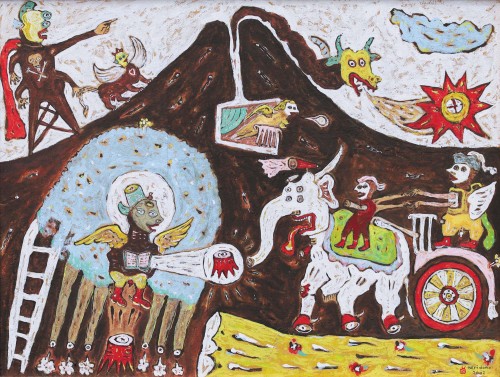
Heri Dono
Land from Merapi; 2002
71 x 94cm; Acrylic and collage on canvas
Est. SGD 13,000 – 17,000
During the early 1990s, Heri Dono made an appeareance as the first Indonesian artist to make a mark in the global art scene. His achievements were recognized by Artlink, an esteemed Australian art magazine, which highlighted him as the most internationally-invited artist from 1993 to 2006. Being acknowledged as one of the 100 leading Avant-Garde artists worldwide, he stood out as the sole contemporary Indonesian artist to receive an invitation to the prestigious Venice Biennial curated exhibition in 2003.
Throughout his career, he has garnered several accolades, including the Dutch Prince Claus Award for Culture and Development (1998), the UNESCO Prize (2000), and the Anugerah Adhikarya Rupa (Visual Arts Award) from the Indonesian government in 2014. He has actively participated in over 300 exhibitions and 41 international biennales including the Asia Pacific Triennial (1993 & 2000), Gwangju Biennale (1995 & 2006), Sydney Biennale (1996), Shanghai Biennale (2000), and multiple editions of the Venice Biennale (2003 & 2015). Additionally, he has been featured in the Sharjah Biennial (2005 & 2023), Guangzhou Triennale (2011), Kochi-Muziris Biennale (2018), Bangkok Art Biennale (2018), and Gangwon Kids Triennale (2020) in South Korea.
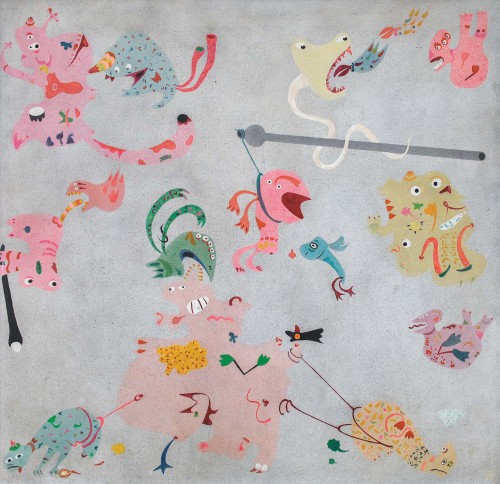
Heri Dono
The 25th Episode, 1985
145 x 145cm; Acrylic on canvas
Est. SGD 20,000 – 30,000
Quoted from Heri Dono about this painting titled “Tanah Dari Merapi,” when he met Mbah Marijan, the spiritual guardian of Mount Merapi, Yogyakarta, he conducted the Ruwatan Bumi ceremony to honor Earth Day. He temporarily borrowed a plot of land and showcased it in front of the Yogyakarta Palace. Following three weeks, he restored the land to its initial location on Mount Merapi.
"The 25th Episode" is a work by Heri Dono created in 1985 while he was still a student at the Yogyakarta Indonesian Art Institute. Cartoons were not considered part of fine art at that time. He combines the concepts of animation and animism, believing that every object possesses its own spirit. He views comics and cartoons as real entities, similar to animist beliefs. Through this painting, the artist conveys that all objects, visible or invisible, are creatures that exist and can be depicted by an artist. The title "Episode 25" signifies the point in Heri Dono's life, at age 25, when he considered the creatures at the bottom of the deepest ocean or beyond Earth's atmosphere to have diverse forms.
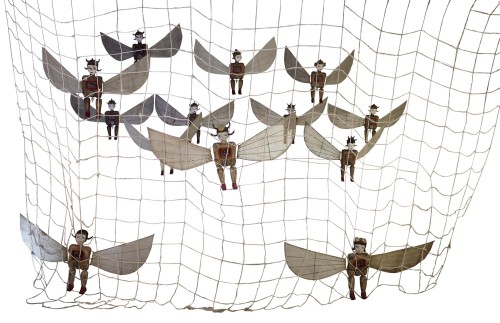
Heri Dono
Flying Angels; 1996
Fiberglass, mechanical system, net
Est. SGD 40,000 – 60,000
"Angels Caught on the Trap" is a piece created in 1996 and first exhibited that same year at the São Paulo Biennale in Brazil. The French artist Gustave Courbet once said, "Show me an angel, I will paint one." In the history of modern Western art, angels have typically been viewed through a religious lens. However, the angels in this work are not associated with specific religious issues because Heri Dono sees angels as symbols of inspiration. This inspiration continuously moves forward, similar to imagination, fantasy, intuition, and human perception.This work portrays angels captured in nets, symbolizing the prohibitions and censorship imposed by state institutions on matters that opposed the ideology of the New Order government at that time. This situation makes it difficult for the angels, as symbols of inspiration, to break free from their constraints. In addition to these works, Global Auction is also offering works by notable artists such as Trubus Sudarsono, Arie Smit, Theo Meier, But Muchtar, Nasirun, Mochtar Apin, Dullah, Popo Iskandar, Djoko Pekik, Abdul Aziz, Ivan Sagita, Oesman Effendi, G. Sidharta, Amrus Natalsya, Fadjar Sidik, Widayat, and many more.
Come visit our art preview before joining our online live auction on June 26 at 7:00 PM (JKT), which will close online live at http://bid.global.auction. For more information, please visit http://global.auction and get in touch with one of our marketing specialist.



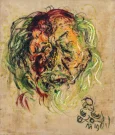


![MAESTRO HIGHLIGHT JANUARY AUCTION [LIVE AUCTION 31 Januari 2026] | global auction](https://i.ytimg.com/vi/1swY91ZHU_c/hqdefault.jpg)
![GLOBAL AUCTION: Southeast Asian, Chinese, Modern & Contemporary Art [14 - 31 JAN 2026] | global auction](https://i.ytimg.com/vi/uxYAvesj170/hqdefault.jpg)


